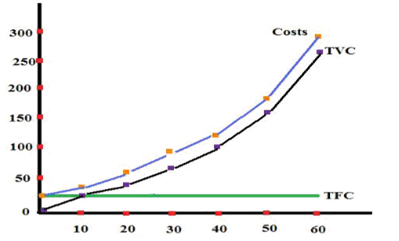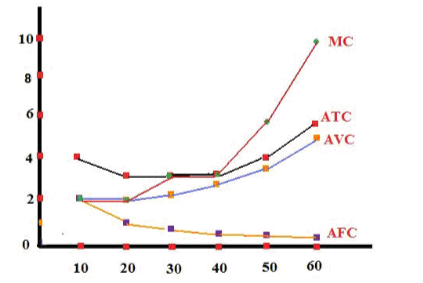
(a)
To compute:
The values of TFC, TVC, AFC,
Answer to Problem 2E
| Total Output | Cost | TFC | TVC | AFC | AVC | ATC | MC |
| 0 | $20 | 20 | 0 | ||||
| 10 | $40 | 20 | 20 | 2 | 2 | 4 | 2 |
| 20 | $60 | 20 | 40 | 1 | 2 | 3 | 2 |
| 30 | $90 | 20 | 70 | 0.66 | 2.33 | 3 | 3 |
| 40 | $120 | 20 | 100 | 0.5 | 2.5 | 3 | 3 |
| 50 | $180 | 20 | 160 | 0.4 | 3.2 | 3.6 | 6 |
| 60 | $280 | 20 | 260 | 0.33 | 4.33 | 4.66 | 10 |
Explanation of Solution
TFC is the total fixed cost, TVC is the total variable cost, AFC is the Average fixed cost, AVC is the average variable cost, ATC is the average total cost and MC is the marginal cost.
TFC is constant all throughout the production process; so, the TFC when the output is 0, at 0 level output total cost is 20, which implies that the TFC is 20.
TVC can be calculated by the following relation.
AFC:
AFC is calculated by dividing TFC with output.
AFC at 10 units,
AVC:
AVC is the average variable cost byoutput.
AVC at 10 units,
ATC:
ATC is the total cost by output.
ATC at 10 units,
MC is the change in total cost per an additional unit.
MC=
MC at 20th unit is,
Total fixed cost:
The cost incurred by a firm which remains constant irrespective of level of output.
Total variable cost:
The cost incurred in producing units of output which varies with the production level.
Total cost:
The sum of total variable cost and total fixed cost is referred as total cost.
Marginal Cost:
The additional cost of producing an extra unit of output is referred to as the marginal cost of producing that unit of output.
Average cost:
It is the cost of per unit of output produced. It is calculated by dividing total cost with variable units of output.
Average fixed cost:
It is the fixed cost divided by units of output.
Average variable cost:
It is total variable cost divided by units of output.
(b)
To illustrate:
The graphical representation of cost
Explanation of Solution
The graphical representation of cost curves is as shown below:


Total fixed cost:
The cost incurred by a firm which remains constant irrespective of level of output.
Total variable cost:
The cost incurred in producing units of output which varies with the production level.
Total cost:
The sum of total variable cost and total fixed cost is referred as total cost.
Marginal Cost:
The additional cost of producing an extra unit of output is referred to as the marginal cost of producing that unit of output.
Average cost:
It is the cost of per unit of output produced. It is calculated by dividing total cost with variable units of output.
Average fixed cost:
It is the fixed cost divided by units of output.
Average variable cost:
It is total variable cost divided by units of output.
(c)
To explain:
The quantity of output at which marginal cost equal average total cost and average variable cost.
Explanation of Solution
At output level 30 and 40, MC is equal to ATC; this is the minimum ATC point.
At 10 units and 20 units, MC is equal to AVC.
Total fixed cost:
The cost incurred by a firm which remains constant irrespective of level of output.
Total variable cost:
The cost incurred in producing units of output which varies with the production level.
Total cost:
The sum of total variable cost and total fixed cost is referred as total cost.
Marginal Cost:
The additional cost of producing an extra unit of output is referred to as the marginal cost of producing that unit of output.
Average cost:
It is the cost of per unit of output produced. It is calculated by dividing total cost with variable units of output.
Average fixed cost:
It is the fixed cost divided by units of output.
Average variable cost:
It is total variable cost divided by units of output.
Want to see more full solutions like this?
Chapter 22 Solutions
EBK MINDTAP ECONOMICS FOR BOYES/MELVIN'
- Use the Feynman technique throughout. Assume that you’re explaining the answer to someone who doesn’t know the topic at all. Write explanation in paragraphs and if you use currency use USD currency: 10. What is the mechanism or process that allows the expenditure multiplier to “work” in theKeynesian Cross Model? Explain and show both mathematically and graphically. What isthe underpinning assumption for the process to transpire?arrow_forwardUse the Feynman technique throughout. Assume that you’reexplaining the answer to someone who doesn’t know the topic at all. Write it all in paragraphs: 2. Give an overview of the equation of exchange (EoE) as used by Classical Theory. Now,carefully explain each variable in the EoE. What is meant by the “quantity theory of money”and how is it different from or the same as the equation of exchange?arrow_forwardZbsbwhjw8272:shbwhahwh Zbsbwhjw8272:shbwhahwh Zbsbwhjw8272:shbwhahwhZbsbwhjw8272:shbwhahwhZbsbwhjw8272:shbwhahwharrow_forward
- Use the Feynman technique throughout. Assume that you’re explaining the answer to someone who doesn’t know the topic at all:arrow_forwardUse the Feynman technique throughout. Assume that you’reexplaining the answer to someone who doesn’t know the topic at all: 4. Draw a Keynesian AD curve in P – Y space and list the shift factors that will shift theKeynesian AD curve upward and to the right. Draw a separate Classical AD curve in P – Yspace and list the shift factors that will shift the Classical AD curve upward and to the right.arrow_forwardUse the Feynman technique throughout. Assume that you’re explaining the answer to someone who doesn’t know the topic at all: 10. What is the mechanism or process that allows the expenditure multiplier to “work” in theKeynesian Cross Model? Explain and show both mathematically and graphically. What isthe underpinning assumption for the process to transpire?arrow_forward
- Use the Feynman technique throughout. Assume that you’re explaining the answer to someone who doesn’t know the topic at all: 15. How is the Keynesian expenditure multiplier implicit in the Keynesian version of the AD/ASmodel? Explain and show mathematically. (note: this is a tough one)arrow_forwardUse the Feynman technique throughout. Assume that you’re explaining the answer to someone who doesn’t know the topic at all: 13. What would happen to the net exports function in Europe and the US respectively if thedemand for dollars rises worldwide? Explain why.arrow_forward20. Given the mathematical model below, solve for the expenditure multiplier for a) government spending, G; and b) for consumer taxes, T. (medium difficulty) Y=C+I+G C=Co+b(Y-T) 1 = 10 T=To+tY G = Go+gYarrow_forward
- Use the Feynman technique throughout. Assume that you’re explaining the answer to someone who doesn’t know the topic at all: 11. What exactly is a rectangular hyperbola and what relevance is it to classical economics?arrow_forwardUse the Feynman technique throughout. Assume that you’re explaining the answer to someone who doesn’t know the topic at all: 9. Explain the difference between absolute and comparative advantage in a family setting, i.e.using parents and children. What can we glean from knowing about comparative andabsolute advantages?arrow_forwardUse the Feynman technique throughout. Assume that you’re explaining the answer to someone who doesn’t know the topic at all: 18. Explain why most economists believe it is absolutely necessary to allow free trade in aneconomy. Why is it harmful (under most circumstances) to have tariffs and trade barriers?arrow_forward
 Exploring EconomicsEconomicsISBN:9781544336329Author:Robert L. SextonPublisher:SAGE Publications, Inc
Exploring EconomicsEconomicsISBN:9781544336329Author:Robert L. SextonPublisher:SAGE Publications, Inc Microeconomics: Private and Public Choice (MindTa...EconomicsISBN:9781305506893Author:James D. Gwartney, Richard L. Stroup, Russell S. Sobel, David A. MacphersonPublisher:Cengage Learning
Microeconomics: Private and Public Choice (MindTa...EconomicsISBN:9781305506893Author:James D. Gwartney, Richard L. Stroup, Russell S. Sobel, David A. MacphersonPublisher:Cengage Learning Economics: Private and Public Choice (MindTap Cou...EconomicsISBN:9781305506725Author:James D. Gwartney, Richard L. Stroup, Russell S. Sobel, David A. MacphersonPublisher:Cengage Learning
Economics: Private and Public Choice (MindTap Cou...EconomicsISBN:9781305506725Author:James D. Gwartney, Richard L. Stroup, Russell S. Sobel, David A. MacphersonPublisher:Cengage Learning Economics (MindTap Course List)EconomicsISBN:9781337617383Author:Roger A. ArnoldPublisher:Cengage Learning
Economics (MindTap Course List)EconomicsISBN:9781337617383Author:Roger A. ArnoldPublisher:Cengage Learning





